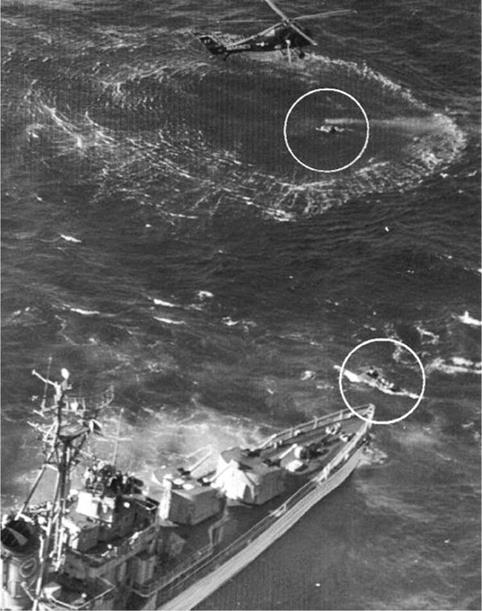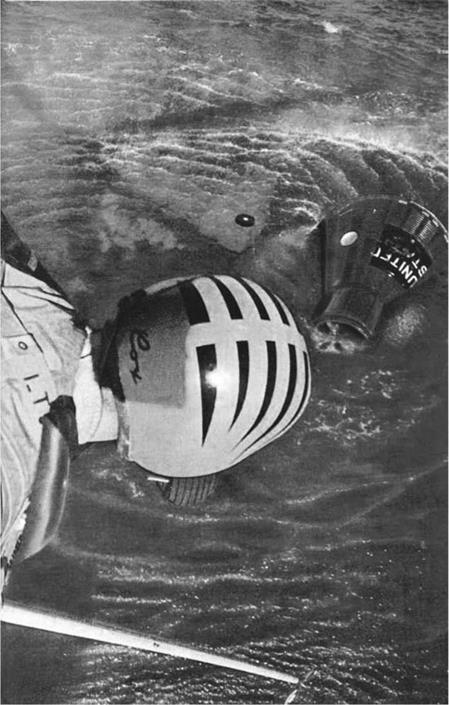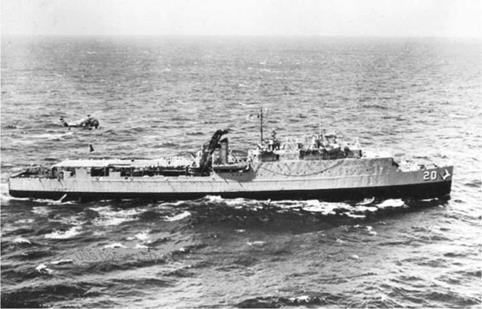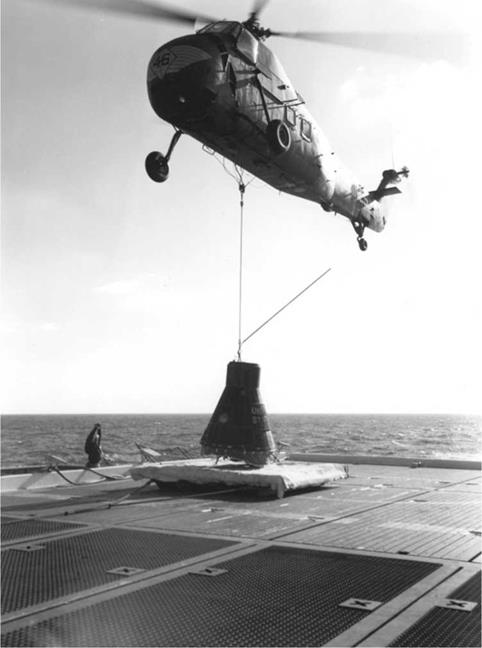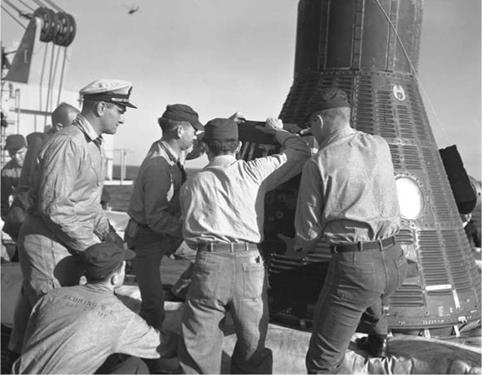SPACECRAFT RECOVERY
Meanwhile the landing ship dock USS Donner (LSD-20), which had previously been involved in Mercury-Redstone recovery trials, was proceeding at flank speed to the reported landing area, together with Task Force destroyers USS Ellison, Borie, and Manley. Twenty-seven minutes after splashdown, airman technician Jerry Bilderback aboard a Navy P2V Neptune patrol plane became the first person to spot the capsule pitching around in white-capped seas. Unfortunately, the overshoot meant that the Donner was still some 60 miles away and it was almost an hour before the helicopter dispatched by the ship with pilots John Hellriegel and George Cox was able to reach the scene.
Once they were hovering overhead, the pilots alarmingly reported that the capsule was tilted on its side in a seven-foot swell, and it appeared to be sitting much deeper than expected in the water. By now, the destroyer USS Ellison had reached the site. With no time to spare, two trained frogmen quickly jumped out of the helicopter and attached cables to fixed points on the wallowing spacecraft to help keep it upright in the water. As the helicopter hovered, Cox reached down from the lower cabin with a shepherd’s hook and attached a towline from the aircraft to a loop on the capsule.
At 2:52 p. m. Hellriegel applied full power and slowly hoisted the MR-2 capsule, streaming seawater, into the air. The precious cargo was flown all the way back to the USS Donner and gently deposited onto the deck at 3:38 p. m., where willing hands soon secured it. This good news was relayed to Cape Canaveral nearly three hours after liftoff.
When it was safe to do so, the spacecraft’s steel hatch was removed, exposing the canister with Ham inside. The sailors involved also noticed a foot and a half of salt water sloshing around inside the capsule. It was later estimated the spacecraft had taken on about 800 pounds of sea water, but was otherwise in good shape. Happily, the water had not infiltrated Ham’s container. He was unaware of how close he had come to sinking ignominiously to the bottom of the Atlantic.
Meanwhile, doctors back at the Cape were deeply concerned that Ham might have been injured during the crushing forces of the flight, or through the hard splashdown. About 35 minutes after reaching the ship, Ham’s container was resting on the deck. One very confused chimpanzee could be heard squealing his discontent from within. The window was fogged over, but it cleared when oxygen was fed in through a small hatch, and Ham came into view.
“He’s alive,” reported a relieved Maj. Richard Benson, an Air Force veterinary doctor. “He’s talking to us.” The sailors then opened a small porthole to enable the veterinarian to insert his hand. Ham cried steadily. “That could mean some anxiety,” Benson told the surrounding sailors. “He’s just vocalizing.”
|
|
Ham’s spacecraft (circled at top) with the recovery helicopter overhead. At bottom (also circled) are two men in a raft near the bow of the USS Ellison. Their task was to right the capsule and help to attach a tow line so that it could be hoisted out of the water. (Photo: U. S. Navy)
|
George Cox prepares to hook onto the wallowing spacecraft. (Photo: NASA) |
|
Ham’s spacecraft arriving by helicopter above the USS Donner. (Photo: U. S. Navy) |
One sailor who got a glimpse of the animal was asked, “How does he look?” “Fine,” replied the sailor. “He’s smiling at me.”
Ham was turning his head from side to side, watching the onlookers curiously and licking his pink chops. He reached a couple of the fingers of his right hand through the port to grasp the hand of Benson. Then he rubbed his face and eyes and yawned. When the Plexiglas lid had been fully removed from the container, he once again shook hands with Benson, burped, and folded his arms across his chest while the veterinarian checked his heart rate with a stethoscope. Benson then reached down to test the animal’s diapers. “They’re damp,” he said with a smile.
Following the brief checkup, Benson happily announced, “On the basis of this preliminary examination I’d say he looks very good. It is very encouraging.” [10] Ham was carried to the ship’s battle dressing station and placed on a white table, where he was carefully unstrapped from his couch. Once again Benson checked the chimpanzee’s heart rate, as well as his temperature, respiration, and lung conditions, and looked for any evidence of broken bones. Unsurprisingly, Ham did display some signs of fatigue, a little wobbling and trembling of his legs when standing, and he had somehow sustained a slight abrasion to the bridge of his nose.
Apart from the facial abrasion everything was fine, and Ham’s reflexes were also found to be normal. Benson then produced a shiny red apple, at which Ham became excited, jumping and reaching out in anticipation. Benson cut the apple and fed it to him in slices as a post-flight treat, which he eagerly devoured. The flight had clearly
|
Pilot John Hellriegel gently lowers the MR-2 capsule onto a platform. (Photo: U. S. Navy) |
|
Opening the hatch on Ham’s capsule. (Photo: NASA) |
not affected Ham’s appetite. While he ate, Ham stood with his arm around the major, and later consumed half an orange along with a small wedge of lettuce.
Later, with Benson sleeping in an adjoining stateroom, Ham spent the night in the commodore’s quarters as the ship steamed across a moonlit ocean for Grand Bahama Island. It was not exactly a trip of luxury, because he was in a cage on the floor of the bathroom, lashed to the toilet and the safety rail that was designed to prevent one from slipping after a shower aboard a rolling, pitching ship. But these were merely safety precautions aimed at protecting precious government research property [11].











